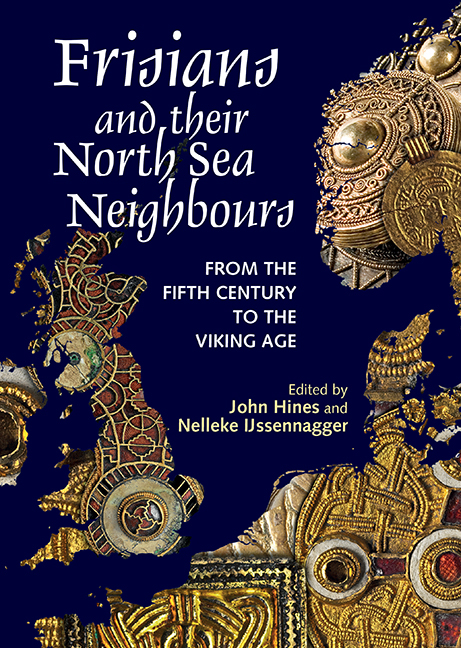Book contents
- Frontmatter
- Contents
- List of Figures
- List of Tables
- Preface
- Acknowledgements
- Linguistic Conventions and Abbreviations
- Abstracts
- Introduction: Frisians – Who, When, Where, Why?
- 1 Palaeogeography and People: Historical Frisians in an archaeological light
- 2 The Anglo-Frisian Question
- 3 Frisian between the Roman and the Early Medieval Periods: Language contact, Celts and Romans
- 4 ‘All quiet on the Western Front?’ The Western Netherlands and the ‘North Sea Culture’ in the Migration Period
- 5 Power and Identity in the Southern North Sea Area: The Migration and Merovingian Periods
- 6 How ‘English’ is the Early Frisian Runic Corpus? The evidence of sounds and forms
- 7 The Geography and Dialects of Old Saxon: River-basin communication networks and the distributional patterns of North Sea Germanic features in Old Saxon
- 8 Between Sievern and Gudendorf: Enclosed sites in the north-western Elbe–Weser triangle and their significance in respect of society, communication and migration during the Roman Iron Age and Migration Period
- 9 Cultural Convergence in a Maritime Context: Language and material culture as parallel phenomena in the early-medieval southern North Sea region
- 10 The Kingdom of East Anglia, Frisia and Continental Connections, c. ad 600–900
- 11 A Comparison of the Injury Tariffs in the Early Kentish and the Frisian Law Codes
- 12 Cultural Contacts between the Western Baltic, the North Sea Region and Scandinavia: Attributing runic finds to runic traditions and corpora of the Early Viking Age
- Index
6 - How ‘English’ is the Early Frisian Runic Corpus? The evidence of sounds and forms
Published online by Cambridge University Press: 25 August 2018
- Frontmatter
- Contents
- List of Figures
- List of Tables
- Preface
- Acknowledgements
- Linguistic Conventions and Abbreviations
- Abstracts
- Introduction: Frisians – Who, When, Where, Why?
- 1 Palaeogeography and People: Historical Frisians in an archaeological light
- 2 The Anglo-Frisian Question
- 3 Frisian between the Roman and the Early Medieval Periods: Language contact, Celts and Romans
- 4 ‘All quiet on the Western Front?’ The Western Netherlands and the ‘North Sea Culture’ in the Migration Period
- 5 Power and Identity in the Southern North Sea Area: The Migration and Merovingian Periods
- 6 How ‘English’ is the Early Frisian Runic Corpus? The evidence of sounds and forms
- 7 The Geography and Dialects of Old Saxon: River-basin communication networks and the distributional patterns of North Sea Germanic features in Old Saxon
- 8 Between Sievern and Gudendorf: Enclosed sites in the north-western Elbe–Weser triangle and their significance in respect of society, communication and migration during the Roman Iron Age and Migration Period
- 9 Cultural Convergence in a Maritime Context: Language and material culture as parallel phenomena in the early-medieval southern North Sea region
- 10 The Kingdom of East Anglia, Frisia and Continental Connections, c. ad 600–900
- 11 A Comparison of the Injury Tariffs in the Early Kentish and the Frisian Law Codes
- 12 Cultural Contacts between the Western Baltic, the North Sea Region and Scandinavia: Attributing runic finds to runic traditions and corpora of the Early Viking Age
- Index
Summary
In my habilitation thesis (Waxenberger 2010) I considered, amongst other things, the earliest runic inscriptions in England, from the period c. ad 400–650. By comparing them to the later inscriptions I found that the English runic corpus can be divided into two sub-corpora: a small Pre-Old English (Pre-OE) corpus (Fig. 6.1) and a larger Old English (OE) one (Fig. 6.2).
At the inception of runic writing in England, the Pre-OE inscriptions were written in the pre-fuþorc, which was based closely on the original Common Germanic (CGmc) fuþark (= ‘older fuþark’) of 24 characters with some enlargement and modifications (which are discussed in the course of this paper) during the period c. ad 400–610/650; that is, down to the time of the Caistor-by-Norwich brooch (c. ad 610–50). This inscription is of the utmost importance because it shows the new runes with their new phonemic sound-values for the first time. I regard the period of c. ad 610/650 as the beginning of Old English because all the relevant sound-changes were completed by then (Waxenberger, forthcoming, ch. 3). It is crucial to note that the Pre-OE inscriptions reflect early sound-changes that had otherwise only been reconstructed on linguistic principles in handbooks that did not take runic inscriptions into account.
Since the academic discussion on the question of whether or not there was ever an ‘Anglo-Frisian unity’ has been rekindled (see Nielsen 1994 for an overview), it seemed methodologically justified to build on the findings for the Pre-OE corpus and see to what extent the Frisian corpus shows congruence with it. Therefore I use the soundchanges of Pre-OE as a framework and examine how the Frisian runes and the soundvalues they represent fit into that frame. I also look at some of the rune-forms in order to shed more light on the characteristics of the Frisian corpus. It is stressed that this is work in progress. The difficulties of such an undertaking need to be made clear from the outset.
The periodization of Old Frisian compared to Old English
Compared to other Germanic languages such as English and German, the attestation of a historical stage of Frisian is relatively late.
- Type
- Chapter
- Information
- Frisians and their North Sea NeighboursFrom the Fifth Century to the Viking Age, pp. 93 - 124Publisher: Boydell & BrewerPrint publication year: 2017
- 1
- Cited by



